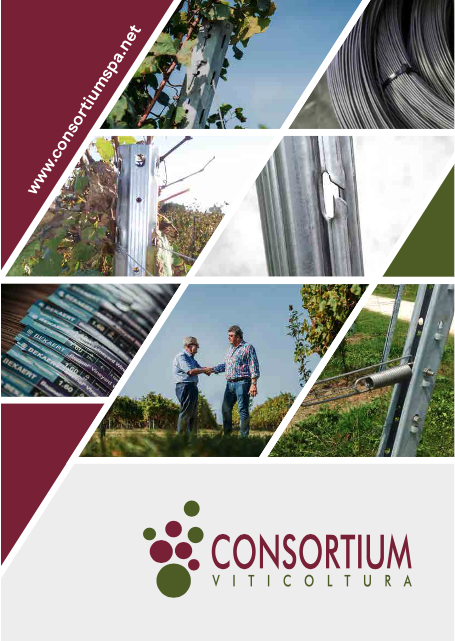GENERAL ASPECTS
Guyot is a form of renewable trellis training that is mainly used in environments with medium to low fertility and medium to high quality goals. In fact, it is mostly widespread in hillside, southern environments and in all those wineries that produce quality wines.
TYPES
Variants of Guyot are:
- Classic (Single or Double)
- Modified (Single or Double)
Classical Guyot is preferred to Modified in cases where the set production goals are achieved without the need to recover a few buds by bending and for cultivars that exhibit optimal and uniform sprouting along the productive shoot without the need for bending
Example:
Cultivar: Merlot
Location: hills of central Italy
Production goal: 2.00 kg./stem
Assuming an average weight per cluster of 170÷200 g and a real fertility of 1.5÷1.7 we realize that 6÷8 buds are needed. With such buds the arch is very short and ensures excellent budding even if placed horizontally so it is advisable to adopt the Classic Guyot.
Single Guyot is preferred over double when operating with varieties that are not very vigorous, in less fertile situations (shorter distances on the row) and with not high production requirements per vine (low to medium number of buds per vine).
It should be remembered that spring-summer bud management is easier and more rational in the Classic Guyot than in the Modified in view of the different orientation and positioning of the buds.
SIXTH OF PLANTING
Distance between rows
There are two possibilities:
- Traditional mechanization: in this case, 80÷10 cm. total respect is calculated between the measure of the distance between rows and the width of the machinery yard. so the measure varies from 2.00 mt to 2.70 mt
- Mechanization with trenchers: in this case the distance between rows, depending on the situation, can vary from a minimum of 1.00 mt to 1.80 mt Finally, it should be remembered that the distance between rows should be equal to or greater than the height of the leaf wall.
Example 1
Variety: good vigor
Environment: hilly south-central
Planting: Single Guyot Classic
Machine yard: width 1.30 mt
Recommended planting size: 2.00÷2.20 m between rows and 0.70÷0.80 m on the row.
Example 2
Variety: vigorous
Environment: northern plains
Planting: Single Guyot Modified
Machine yard: width 1.60 mt
Recommended planting size: 2.50÷2.60 m between rows and 1.00 m on the row.
Distance on the row
The arrangement of the rooted vines in the row must be the balance point between a rational use of space on the one hand and an adequate vegetative balance of the system on the other. In fact, with equal row spacing and buds per hectare, more plants in the row reduces production per vine and increases grape quality.
However, all this is only valid if an optimal balance of the vegetative-productive expression of the vineyard system is achieved.
Therefore, it can be summarized as follows:
- Single Guyot: 0.70÷1.10 mt
- Double Guyot: 0.90÷1.40 mt
MECHANIZATION
In the different forms of breeding that involve raising new shoots, with the same planting pattern, the main difference in management costs concerns dry pruning.
In the case of Guyot, there are currently no solutions to perform real mechanical pre-pruning. So from this point of view, Guyot is a form of breeding that has the limitation of presenting a significant winter workload that cannot be mechanized.
Some considerations on the use of CONSORTIUM metal poles.
Regarding more favorable mechanization very interesting is the solution using metal poles (hot-dip galvanized, pre-galvanized, Zinc-Magnesium covered, corten type, stainless steel).
In fact, this type of piling has a number of advantages that can be summarized as follows:
- Small section and considerable elasticity so they are ideal for good mechanized harvesting;
- Possibility of modular, economical and customized management of vertical space. In fact, these poles allow wires (fixed or movable) to be fixed every 10 cm. without the need to use other accessories (ties, nails, brackets, etc.) which cost both as materials and labor to install and also bind to certain measurements throughout the age of the vineyard;
- They take up little space;
- Easy and cheaper to distribute and plant;
- Long service life and therefore no maintenance cost. This aspect is especially important compared to the wooden brace, which in any case, over the life of a vineyard, requires a replacement quota.
An additional general consideration about metal poles that deserves further consideration is the type of profile of the pole itself. Smooth profiles (inner slots) are certainly preferable to profiles with outer fins. In fact, these fins are an element of heavy wear and tear for grape harvester beaters and, moreover, due to the type of conformation they present a critical point of structural weakness at their base whereby, over time, they can first crack and then detach from the pole itself. Finally, in "touch-up" vineyards and windy areas. With external fin profiles, the wires tend more easily to slip out of their position.

